
好きなことを仕事に選んだ、それぞれの分野の達人たちは、
私生活でどんなことに夢中になっているのか?
人生の自由時間の過ごし方、そのヒントを探ってみよう。

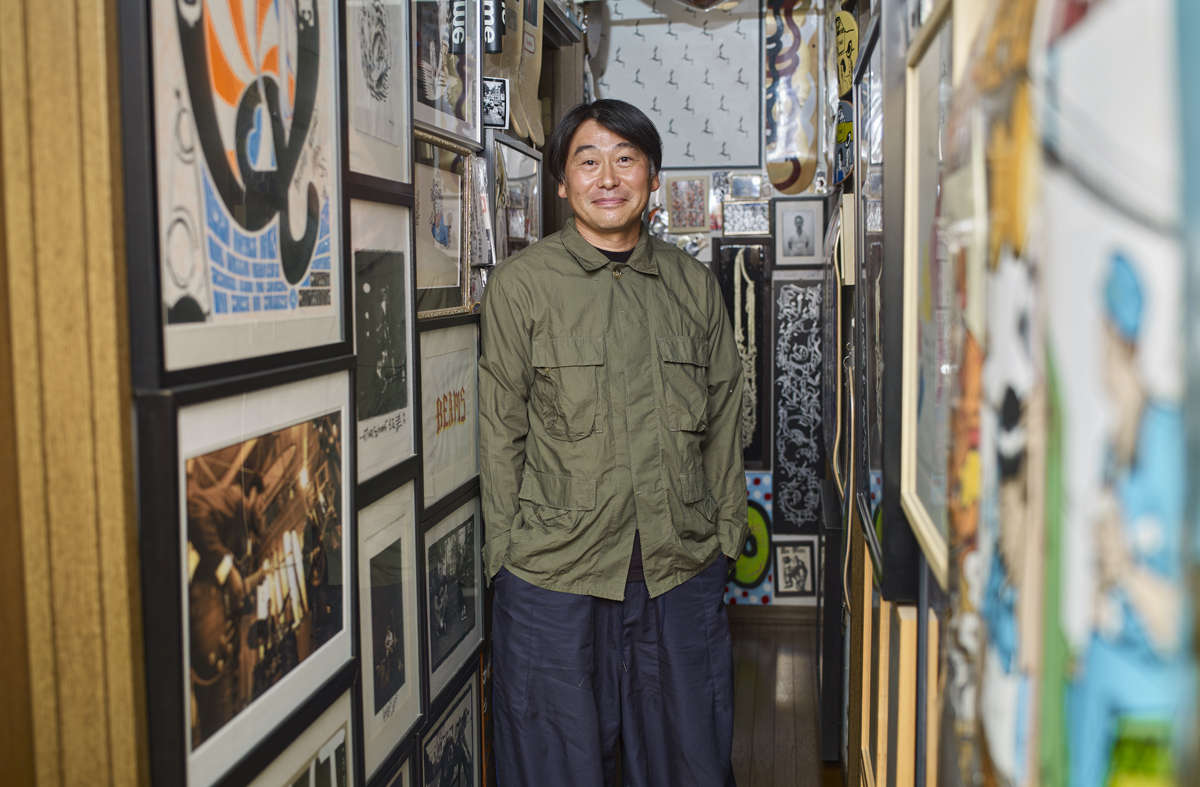

作っている野菜の特徴は 「露地栽培」。 野ざらしで自然のままの太陽光と雨風に当たってじっくり成長するので、 長持ちして味が濃い野菜になります。 温室で育てると、 ふわ〜と柔らかい野菜ができるんですけど、 味にワイルドさがないんですよ。 形は不揃いですが、 じっくり育った野菜はやっぱりうまいです。
We cultivate all our veggies outdoors so that they grow slowly while being exposed to the weather. It makes them tasty and long-lasting. Greenhouse-grown veggies are softer and fluffier, but taste weaker. Though our veggies are irregular in shape, they taste good.

作った “鎌倉野菜” は、 四日に一度のペースで 「レンバイ」 と呼ばれる鎌倉農協連即売所で販売しています。 生産者が消費者に直接販売する西洋型市場の日本最古のものと言われている市場で、 場所は鎌倉の八幡通り。 シェフの方も多くて、 皆さん朝一に仕入れに来られています。 お待ちしてます (笑)。
We sell our ‘Kamakura Vegetables’ at a local farmers’ market once in every four days. It’s said to be the oldest Western-style farmers’ market in Japan. Many of our customers are chefs and they always come there first thing in the morning.

これはヘビナスです。シェフの方からのリクエストがきっかけで、 割と変わった野菜を作っています。 子供にはパンチがありすぎると言われてしまうかもですが、 料理好きには喜ばれることが多いですね。 「 露地栽培 」 の難しさは天候。 このあたりだと潮風などの影響もあって、 全滅なんてことも珍しくありません。
It’s called snake eggplants. We also grow such less-known vegetables because our chef customers want to have them. Outdoor cultivation is highly weather dependent as the salty wind sometimes causes severe damage on the crop in this area.

野菜と一緒に昔から花も作っています。 これは 「 ゴッホのひまわり 」 という名の付いたユニークな品種で、 とても人気があります。 畑の脇の段々になってる場所は耕せないので、 土が崩れ落ちないようにするためにも、 そんなところに花木を植えるんです。 それらが季節ごとに花を咲かせてとても綺麗です。
We have grown flowers together with vegetables since long ago. This one is unique and named Gogh’s Sunflowers. There are some untillable areas in our farm, so we grow flowers and plants there. It’s very beautiful when they bloom.
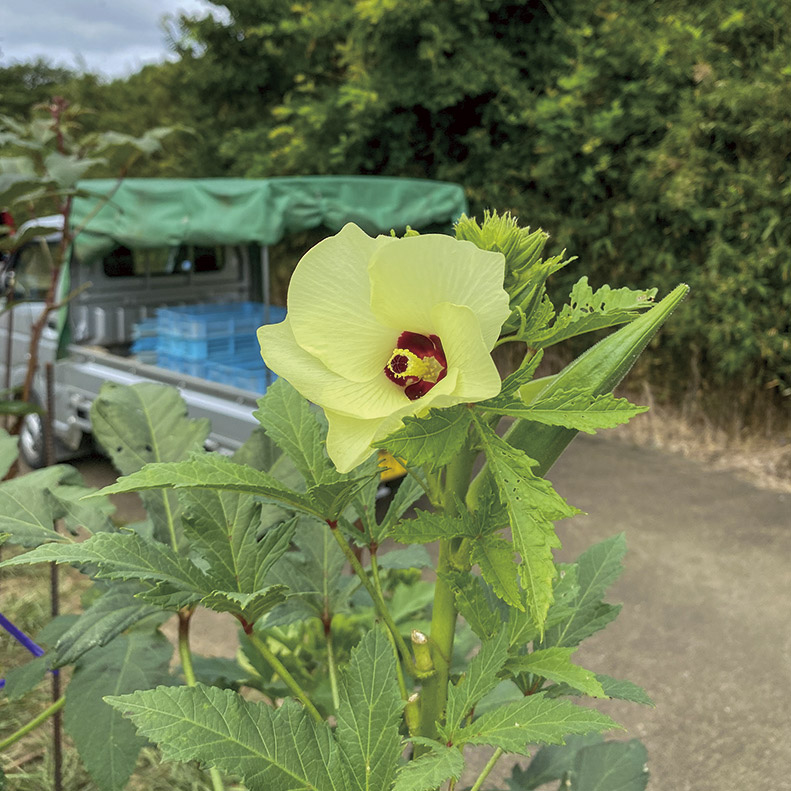
オクラの花です。 葉にも茎にもチクチクするトゲがあって、 オクラは採るのが大変 ! いつも肌が “かせて” (かぶれて) しまいます。
An okra flower. Okra has tiny prickles on the stems and leaves, so it’s not easy picking them. I always get a skin rash.
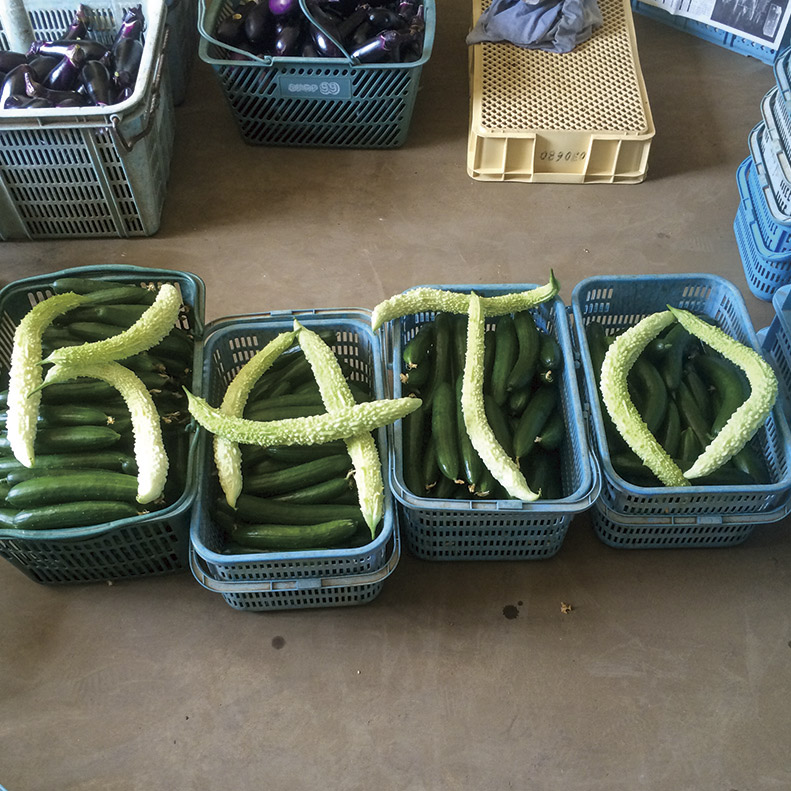
白ゴーヤで屋号を (笑)。 夏は身体がばてるから、 身体に良いものを食べたいという意識から野菜に人気が集まるんだと思います。
White bitter melons spelling our family name. People tend to crave more veggies in summer to supply nutrition.
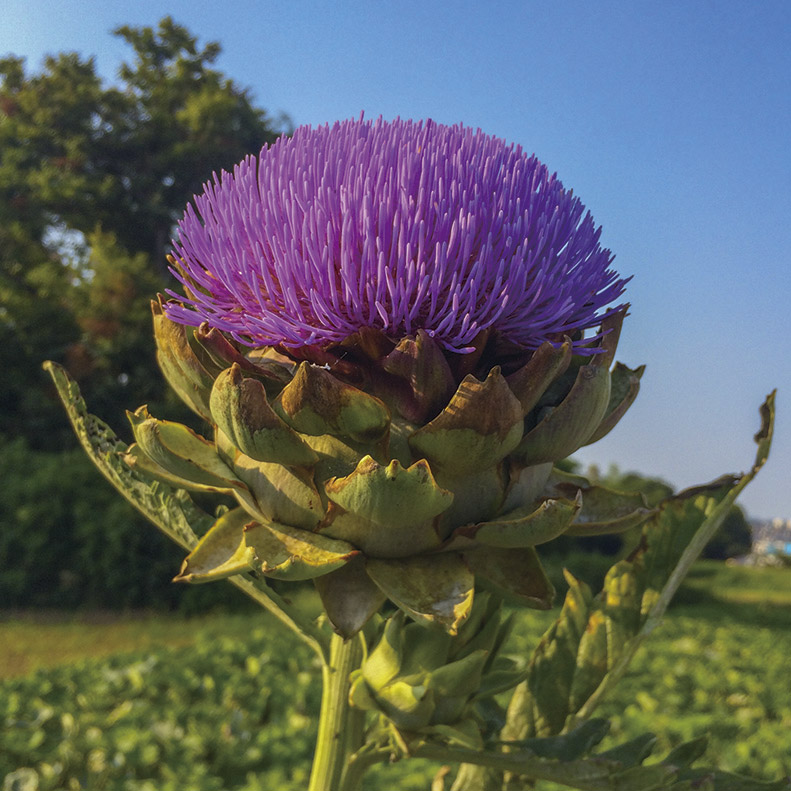
アーティチョークの花です。 食べないで花として買っていく方も多いんです。 水に刺してずっと置いておくと綺麗な花を咲かせてくれます。
An artichoke flower. Some buy them for decorative purposes. Soak them in water and they bear beautiful flowers.
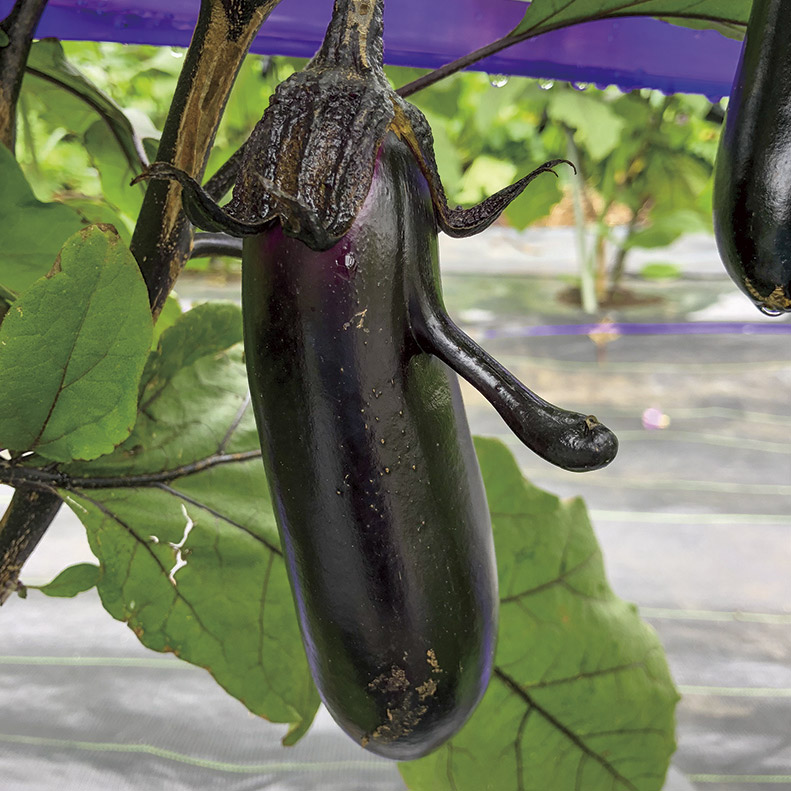
自然が作った想像もつかない変な形に惹かれてしまうんです(笑)。 これなんて髪の毛までついてて、 ヤベェ! ってなりました。
Mother Nature sometimes creates unimaginable things. This one even has hair on it. Just hilarious.
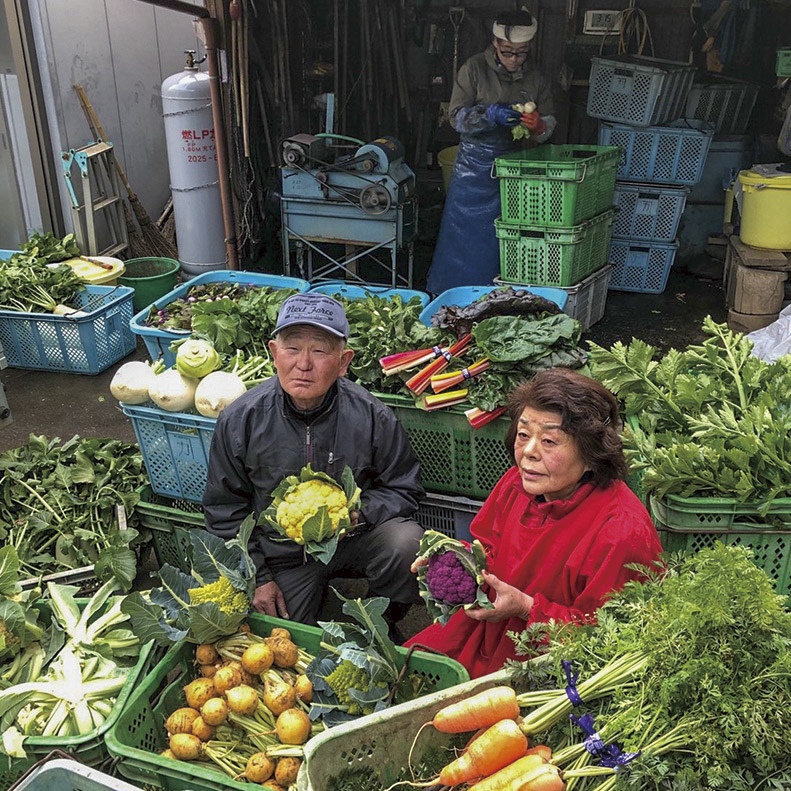
父と母。 兄貴が撮影。 自分も奥に写ってます。 家族は皆仲良し。 週末は双子の兄貴とお姉ちゃんもみんなで市場を手伝ってます。
My parents. My older brother took it and you can also see me in the back. We are such a close family.

白ゴーヤ。 なかなかここまでのものは来ないですね (笑)。 こういうのを見つけるのが、 収穫で一番の楽しみかも。 これもちゃんと売りました。
A white bitter melon. Finding things like this is the best part of harvest. We sold this one at the market, too.

三浦ダイコン。 もちろん普通の形のが大半です (笑)。 秋から冬にかけてたくさん作る野菜です。 夏は少し辛味が出てきますね。
A Miura daikon radish. It’s not the usual shape, you know (laughs). We grow more of them from fall to winter.

「レンバイ」 市場でマーブルビーツを販売中。 このビーツはうちの顔的な野菜です。 売っている野菜の値段は、 感覚でつけてます(笑)。
Me selling our famous Chioggia beets at the local market. I follow my instinct when pricing our veggies (laughs).

ニンジンは一年中切らすな、 がうちの母のポリシーで、 それをずっと守ってます (笑)。 もちろんこんな形はレアです。
My mother always tells us not to run out of carrots all year round. So, we’ve followed her direction for a long time.

赤と緑のオクラ。 赤のオクラは茹でてしまうと色が緑に変わってしまうので、 スライスして生で食べるのが目にも美味しいです。
Red and green okra. Red one changes its color to green after being boiled, so it might be better to eat it raw.

うちの看板選手、 マープルビーツをスライスするとこんな感じです。 彩りがいいのでサラダがおすすめ。 焼いて食べる人もいます。
Sliced Chioggia beets. To show off the lovely rings, I recommend to use them in salad. Some prefer it roasted.

紅白ラディッシュ。 普通のラディッシュはカブ寄りだけど、 これは食感がダイコン寄りで5センチくらいが一番美味しい。 生で食べます。
Small radishes with white tips. It has a daikon-like taste, while normal radishes taste like a turnip. It’s eaten raw.

スイスチャード。 カラフルな色が特徴で、 フランスの田舎料理にも使われます。 小さい葉はサラダ、 大きいものは炒めてパスタがおすすめ。
Swiss chard is known for its vivid colors. The large leaves are good in salad, while the smaller ones match well with pasta.

作業中も普段と同じくおしゃれしたいんだけど、 服が好きすぎて汚れたら嫌なので、 畑だと3軍4軍、 市場だと2軍を着てます (笑)。
I want to wear more stylish clothes in the farm just like I do in town, but I don’t want them to get dirty.

ロマネスコとパープルカリフラワー。 ロマネスコはピラミッド型が面白い。 硬めに茹でるのがおすすめで、 茹でると甘みが出ます。
Romanesco broccolis and purple cauliflowers. I like the broccolis boiled a little hard to make them sweeter.

ヒマワリ、 アジサイ、 ニセナナカマドの花。 お母さんが花好きで、 開花の季節には野菜と一緒に必ず市場に持って行きます。
Sunflowers, hydrangeas and Sorbaria flowers. My mother loves flowers, so we also sell them at the market.

マクワウリ、 バターナッツ、 ゴーヤ、 トランペットズッキーニ。 シェフからのリクエストで作り始めて、 今では一般の人にも人気です。
Oriental melons, butternut squashes, bitter melons and trumpet zucchini. Initially were requests from chefs.

色々な種類のアーティチョーク。 さっと茹でてから、 バターでカリッと焼いて食べると、 ピスタチオみたいな味がするんです。 ぜひお試しを。
We grow many types of artichokes. Boil them quickly and sauté with butter, and they taste like pistachios.